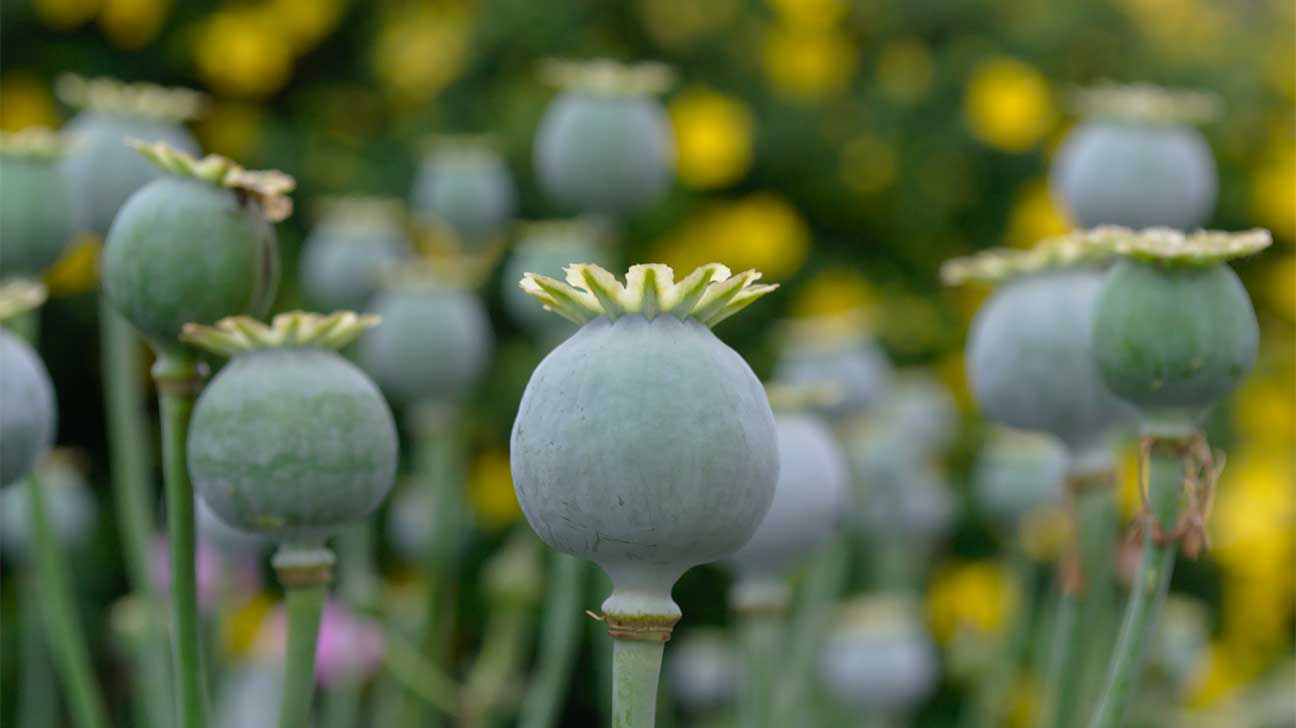
Heroin is an illicit drug that is processed into the form of a powder or sticky substance. The manufacturing process of heroin depends on the type of heroin and where it comes from.
Heroin can come in the following forms:
- white powder
- brown powder
- dark sticky substance (black tar heroin)
Heroin is chemically similar to morphine and codeine, which are commonly prescribed as painkillers. Unlike common opioids, heroin does not have any acceptable medical use in the United States.
Understanding how heroin is made, what it looks like, and where it comes from can be useful in order to identify heroin use in a loved one.
Learn more about heroin abuse and addiction
How Heroin Is Made
Heroin comes from opium poppy plants, which are grown on several different continents throughout the world.
Raw opium is harvested from the seed pods of these plants, which contain a milky fluid. This can be refined to create morphine.
Creating Powder Heroin
Powdered heroin production requires a more extensive process. Black tar heroin can be cut with lactose and further refined to create a brownish powder.
The purest form of heroin is a shiny, white powder, known as diacetylmorphine hydrochloride.
Not all white powder heroin has the same purity level. Much of the heroin sold on the street is cut with additional ingredients, also known as cutting agents, fillers, adulterants, or additives.
Where Does Heroin Come From?
Heroin is a derivative of the natural opiate morphine, which is a drug commonly prescribed to treat severe or chronic pain. Morphine is extracted from the seeds of the opium poppy plant.
Opium poppy plants are produced from poppy seeds, and are grown in Southeast Asia, middle eastern countries such as Turkey, Latin America, and parts of Europe and Australia.
Three main sources for illegal opium include:
- Burma
- Afghanistan
- Colombia
Most of the heroin that comes into the United States is smuggled in through the US-Mexico border, with major entry points being California, Texas, and Arizona.
Read more about what plant heroin is made from
Common Heroin Cutting Agents
Heroin is an unregulated drug that can contain a variety of ingredients. These ingredients, sometimes referred to as cutting agents, can dilute heroin or in some cases increase its effects.
Heroin cutting agents can include:
- powdered milk
- sugar
- caffeine
- starch
- baking soda
- quinine
- soil
- strychnine (rat poison)
Read more about common heroin cutting agents
The Heroin Manufacturing Process
Some people may also try to manufacture heroin from prescription opioid drugs, such as oxycodone and hydrocodone.
During this and other manufacturing processes, heroin may be contaminated with ammonia, acetic anhydride, calcium oxide, hydrochloric acid, and chloroform.
When buying street heroin, it’s impossible to know for sure how the heroin was made and where it comes from. This fact alone makes heroin very dangerous.
The most deadly combination drug is heroin mixed with fentanyl. Fentanyl is a synthetic opioid that is 50 to 100 times more potent than heroin.
This means smaller doses can create more powerful effects, including dangerous effects on the central nervous system.
Fentanyl is a leading driver of drug overdose deaths in the United States. Drug dealers who sell heroin may not know or tell the person they are selling to that their heroin contains fentanyl.
What Are The Dangers Of Heroin?
According to the United Nations Office of Drugs And Crime (UNODC), more than 15 million people worldwide use illicit opiate drugs such as heroin, codeine, and morphine.
Quick facts on the dangers of heroin:
- Nearly 15,000 people in the United States died of fatal drug overdoses involving heroin in 2018.
- Heroin injection is a major risk factor for infectious diseases such as HIV and hepatitis.
- Heroin that is cut with the illicit opioid fentanyl can be very deadly in small doses, due to the high potency of fentanyl.
- Additives in heroin can also be dangerous, particularly when injected. This can clog blood vessels leading to the lungs, kidneys, lungs, and brain, which may lead to permanent damage.
Heroin is an addictive drug. People who use heroin may have difficulty keeping a job, housing, and may live with co-occurring mental illness or chronic pain.
Recovering from heroin addiction isn’t easy, but with treatment, it is possible.
Getting Help For Heroin Abuse And Addiction
Quitting heroin isn’t simple. People who become addicted to heroin may experience withdrawal symptoms if they try to stop their drug use all at once.
This can be highly uncomfortable at best and dangerous at its worst.
Finding a detox program is strongly recommended for anyone who’s addicted to heroin or other illicit drugs. After detox, treatment in an inpatient or outpatient rehab program may be recommended.
Treatment for heroin addiction can include:
- behavioral therapy
- individual counseling
- group therapy
- medication (e.g. methadone, buprenorphine)
- aftercare and supportive housing
Overcoming an addiction to heroin is possible. Call our helpline today to find a heroin addiction treatment program that’s right for you.
Addiction Resource aims to provide only the most current, accurate information in regards to addiction and addiction treatment, which means we only reference the most credible sources available.
These include peer-reviewed journals, government entities and academic institutions, and leaders in addiction healthcare and advocacy. Learn more about how we safeguard our content by viewing our editorial policy.
- Center for Disease Control — Heroin Statistics
https://www.cdc.gov/drugoverdose/data/heroin.html - Drug Science — Heroin
https://drugscience.org.uk/drug-information/heroin/#353836655864128 - National Institute on Drug Abuse — Effective Treatments for Opioid Addiction, Heroin
https://www.drugabuse.gov/publications/effective-treatments-opioid-addiction/effective-treatments-opioid-addiction


